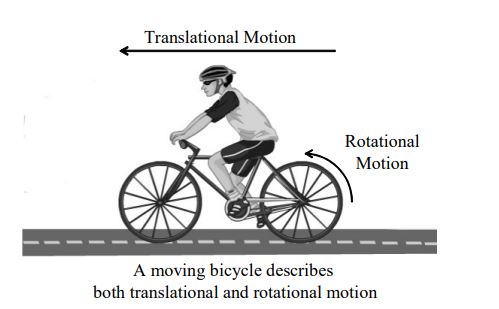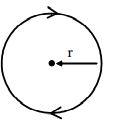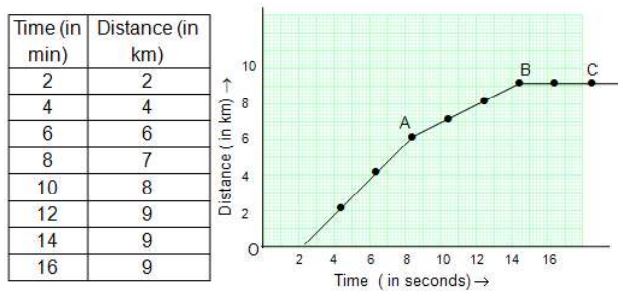1. INTRODUCTION
Mechanics is the branch of physics that focuses on the motion of objects and the forces that cause the motion to change. There are two branches of Mechanics: Kinematics and Dynamics. The word kinematics comes from the Greek word “Kinema” meaning motion. The word dynamics comes from the Greek word “dynamis” meaning power.
Kinematics deals with the concepts that are needed to describe motion without any reference to forces or the cause of the motion. The goal of study of kinematics is to develop sophisticated mental models, which serve us in describing the motion of real world objects.
Dynamics deals with the relation between the forces and the motion. The motion of objects can be described by words such as distance, displacement, speed, velocity and acceleration. Before we witness the concepts of kinematics, let’s review some basic concepts.
2. REST & MOTION
I Rest
A body is said to be at rest if it does not change its position with respect to the reference point. The objects which remain stationary at a place and do not change their position are said to be at rest.
Example : A table and chairs lying in a room are in the state of rest, because they do not change their position with respect to the surroundings of the room.
II. Motion
An object is said to be in motion if it changes its position from one place to another. In other words, the movement of an object is known as the motion of the object.
Example: A vehicle has to be driven.
Rain drops fall due to gravitational pull.
3. TYPES OF MOTION
All bodies in motion do not move the same way. For example, a car moves straight along the road; a spinning top spins round and round; the strings of a sitar move up and down and the pendulum of a clock moves sideways in either direction. The motion of bodies is classified as under:
I Translatory Motion
The motion in which all the particles of a body move through the same distance in the same time is called translatory motion.
Examples :
i) A car or a train moving along a road or track.
ii) A ball rolling on the ground.
iii) Firing of a bullet from a gun.
iv) A stone hurled from a catapult.
vii) An apple falling from a tree.
viii) A striker on the carom board going straight to hit the coin, etc.
There are two kinds of translatory motion:
(a) Rectilinear motion and
(b)Curvilinear motion.
a) Rectilinear Motion
When an object moves along a straight line like a ball dropped from a height, the motion described by the body is called rectilinear motion.
Examples:
i) A ball rolling on the ground.
ii) A car moving on a straight road.
iii) A stone falling freely
iv) A coin moving over a carom board.
b) Curvilinear Motion
When a body moves along a curved path, the motion described by the body is called curvilinear motion.
Examples:
i) A stone thrown by a boy from a height.
ii) A car moving along a curved path.
iii) A javelin or shot-put thrown by an athlete.
iv) A ball thrown upward at an angle.
v) A car or train moving along a curved road or track are all examples of curvilinear motion.
II. Rotational Motion
A motion in which a body moves about a fixed axis without changing its position is called rotational motion.
Examples:
i) The motion of the blades of a fan.
ii) The wheel of a sewing machine.
iii) The motion of a giant wheel.
iv) A spinning top
v) A spinning wheel (charkha)
vi) A rotating potter’s wheel
Combination of Translatory and Rotational Motion
In some cases, the motion of rotation and the motion of translation occur at the same time. When a drill cuts through a metal piece, it performs the motion of translation as well as the motion of rotation at the same time. Other examples of this kind of motion are the wheels of a moving bicycle or a car, the ball delivered by a spin bowler.

III. Circular Motion
When a body moves around a circular path, the way an athlete runs around a circular track, such motion is called circular motion.
Examples:
i) Motion of an electric fan.
ii) Motion of a merry-go- round.
iii) Motion of a spinning top.
iv) Motion of the earth around the sun.
Note: In circular motion, the position of a body itself keeps changing with time, but in rotational motion the position of a body does not change. It is to be noted that circular motion is a special case of rotatory motion.
COMPARISON OF ROTATIONAL AND CIRCULAR MOTIONS
| Rotational Motion | Circular Motion |
| 1. Body stays in same place with moves and changes its position with time. | 1. Body doesn’t stay in same place. It respect to time. |
| 2. The body rotates about an axis may not pass through the body. | 2. It moves along a path whose axis passing through it. |
| 3. No linear motion is observed for the body as a whole. | 3. Body may undergo linear motion. |
IV. Oscillatory Motion
A motion in which the body as a whole moves to-and-fro about its mean position is called oscillatory motion.
Examples :
i) The movement of a swing.
ii) The oscillation of pendulum of a clock.
iii) The needle of a sewing machine moving up and down.
iv) The piston of a motor car, the pressing cylinder of a juice machine, the piston of a spray pump etc.
V. Vibratory Motion
It is another kind of oscillatory motion in which the body does not move as a whole i.e. the entire object does not move but undergoes change in shape or size.
Examples:
i) When you pluck a string of a guitar or sitar, it vibrates to and fro about its position of rest and produces music.
ii) When you strike the membrane of a drum, it vibrates up and down about its position of rest and produces sound. These vibrations are like the oscillations of a pendulum, except that they are faster. There is another difference. The pendulum swings freely, while the string of a musical instrument is fixed at two ends, and the membrane of a drum is fixed around the circumference of the drum.
iii) During breathing, when our chest expands or contracts, the motion is vibratory in nature; all the points on the chest do not move out equally.
VI. Periodic Motion
A motion which repeats itself at regular intervals of time is called periodic motion.
Examples:
i) The motion of the earth round the sun is periodic.
ii) The swinging pendulum of a wall clock.4 Physics
iii) The needle of a sewing machine running at constant speed.
iv) The heartbeat of a normal human being.
v) The motion of a swing.
vi) The movement of the lungs during breathing.
VII. Random Motion
A body which has a particular motion that suddenly changes to another kind of motion is said to have random motion. In other words, the motion without any sequence or direction is random motion.
Examples :
1) A buzzing bee.
2) A football player on the field.
3) The motion of a hockey ball during a game.
4) The flying motion of a sparrow.
5) A monkey performing antics on a tree.
VIII. Multiple Motion
Sometimes an object manifests two or more types of motion at the same time. Such motion is called multiple motion.
Examples:
i) When a spin bowler delivers a ball, the ball has a motion of spin (rotatory motion)while it moves towards the batsman (translatory motion).

ii) A person is drawing water from a well. Here, the pulley on which the rope runs has a rotatory motion while the bucket coming up has a translatory motion.
iii) A girl riding a bicycle. The wheels of the bicycle rotate (rotatory motion ) and at the same time the bicycle moves forward in a straight or curved path (translatory motion).
iv) A drill used by a carpenter for drilling a hole in wood, has both translatory and rotatory motions. This is because while it is being rotated (rotatory motion), it is also getting pushed forward (translatory motion) into the wood.
v) The earth rotates about its axis (rotatory motion) and at the same time it revolves around the sun in a circular path (translatory motion).
vi) The mythological Sudarshan Chakra hurled by Lord Krishna to kill his enemies had both translatory as well as rotatory motion.
4. VECTORS AND SCALARS
Consider a water melon that weighs 5 kg. Here, the mass is represented by the number 5 along with the unit kg. For specifying the mass of the body, direction is not required, but magnitude. Such quantities are called scalars.
The quantities which have only magnitude but no direction are called scalar quantities.
Examples: Mass, length, time, volume, density temperature, etc.
It is right to express mass of water melon as 5 kg, but it is wrong to express mass of water melon as 5kg towards north.
Now assume that you invited your friend for your birthday party and your friend doesn’t know your house. You informed that your house is 200m from a Corporate office.
Will your friend find it easy to locate your house ?
It becomes difficult to trace the house as the direction is not specified.
But if you say it is 200m left or east of the Corporate office, he finds it easy to locate your house and your celebration becomes colourful.
That is, for certain quantities, specification of direction is a must. Such quantities that are represented with both magnitude and direction are called vectors.
Examples: Displacement, velocity, acceleration, force, weight etc.
Representation of a Vector :
Any vector can be represented by a straight line

The length of the straight line indicates magnitude and the arrow mark indicates direction.
5. DISTANCE AND DISPLACEMENT
The actual length covered by a moving body in between two points, irrespective of the direction in which the body is moving, is called distance.
In the figure shown, if the particle performs one complete rotation, then the distance covered by it is

The straight line distance between the initial and final positions of a body is called the magnitude of the displacement. The direction of the displacement is given by the direction from the initial position to the final position.
The shortest distance covered by a moving body in between two points, in a particular direction, is called the displacement.
Consider the following motion depicted in the figure. A man walks 4 metres east, 2 metres south, 4 metres west, finally 2 metres north.

Though the man walked a total distance of 12 metres, his displacement is zero metres. During the course of this motion, he has covered 12 metres of ground (distance = 12m).
Yet when he has finished walking, he is not “ out of place” i.e., there is no displacement for his motion (displacement = 0 m). Displacement, being a vector quantity, must give attention and regard to direction. The 4 metres east is cancelled by the 4 metres west; and the 2 metres south is cancelled by the 2 metres north.
Both distance and displacement are measured in same units. In CGS and SI systems, the units are metre and centimetre respectively.
6. SPEED
The FASTNESS OR SLOWNESS of a body can be understood from the SPEED of the object.
The speed of an object is defined as the distance travelled by it in unit time.
Therefore, an object that moves faster covers more distance in a second (unit time) as compared to an object that moves slower.
We can calculate the speed of an object if we know the distance it travels in a given time.
Units of Speed
The SI unit of speed is metre per second (m/s) and CGS unit is centimetre per second.
Another commonly used unit is kilometre per hour (km/h). When we talk of speed of aeroplanes and cars, it would be more appropriate to use km/h than m/s.
Speed in m/s can be easily converted to km/h by dividing the answer in m/s by 5/18 or multiplying by 18/5.
Instrument used to measure Speed
The instrument/meter measuring the speed of the vehicle is called a speedometer. The distance travelled by the vehicle is given by an instrument called odometer. Both of them are usually fitted together. These instruments will give the reading of speed and the distance travelled at the same time.
Uniform speed
When a body covers equal distances in equal intervals of time (however small the time intervals may be), the car is said to be moving with a uniform speed.
Examples:
A rotating fan, a rocket moving in space, etc., have uniform speeds. Similarly, an aeroplane flying at 200 km/h or a train running at 90 km/h are moving with uniform speeds.
Non-Uniform Speed
When a body covers unequal distances in equal intervals of time, the body is said to be moving with a non-uniform speed.
Examples:
A train starting from a station, a dog chasing a cat, have variable speeds.
Average Speed
In practice, very few objects travel at a constant speed for long. For instance, Your school bus may speed up and slow down many times on the way to school. It is difficult to mention the speed of the bus as its speed varies at each moment. In such cases, to represent the speed of the entire journey, we use the concept of Average Speed.
Average speed is defined as the total distance travelled divided by the total time taken to travel that distance.
7. DISTANCE AND TIME GRAPHS
Generally, a vehicle travelling on a road does not travel at a constant speed throughout its journey. If we note the distance travelled by the object at equal intervals of time (like every second or every minute), we will get a clearer picture of its speed at different points of time.
The data of the distance travelled and the time taken can be presented either in tabular form or graphical form.
The given information can be represented in both ways as shown below

This kind of a chart is called a Line chart or Line Graph.
It is created by plotting a series of data points and connecting them to form a line.
In this we have taken time on the x-axis and the distance on the y-axis.
Some important points to note
• When we try to locate an object, we usually relate it to some sort of reference point. This point is usually the origin, the zero point of an axis (x or y).
• We provide a numeric value for an object’s location by placing it either in the positive direction (+) or the negative direction (–) in relation to that reference point.

We can get the following points by examining the distance – time graph:
1. The steepness of the slope of the graph gives the speed. If the slope is greater (i.e., if the slope is steeper as in line OA of the figure, the speed is greater than the speed shown by line AB, since its slope is flatter).
2. The speed is zero if the graph is flat (i.e., parallel to the ‘time’ axis) as in BC.
3. For a body moving with constant speed, the graph will be a straight line passing through the origin. A motion that can be represented by a straight line as shown in figure is called uniform motion.
In other words, a body is said to be in uniform motion if it covers equal distances in equal intervals of time.









